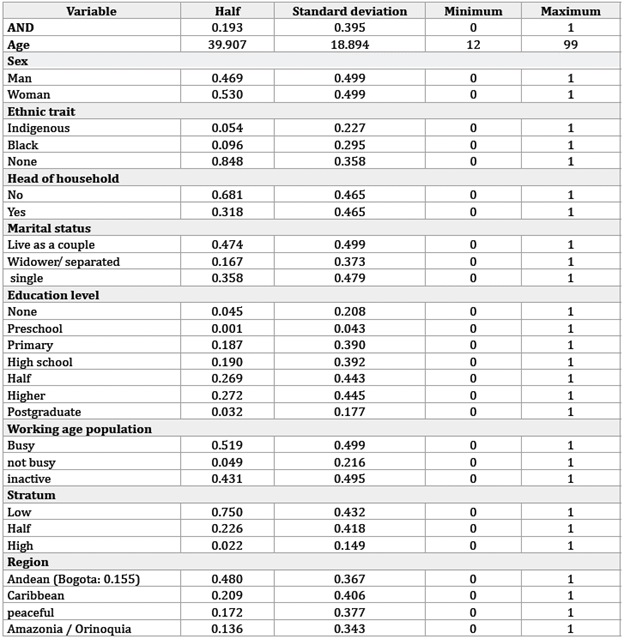INTRODUCTION
The library has been recognized for having a preponderant role in society since it contributes to social development, facing great challenges over time (Vargas, 2012; Shin & Lee, 2022). In Colombia, this institution's fundamental purpose is to increase social capital, promote inclusion, generating equity, education and well-being; gaining special importance in the post-conflict period (Castro et al., 2013; Jaramillo, 2016). Thus, these spaces are contemplated in Law 1379 of 2010, "by which the national network of public libraries is organized and other provisions are issued". Besides, in the National Development Plan 2018-2022, called "Pact for Colombia, pact for equity", in which one of the points is the development of library projects in rural communities for the construction of social fabric and equity, considering that in Colombia the majority of the population who benefits from the use of libraries is the one that is part of the municipal areas. By contrast, the rural areas composed of Afro and indigenous reservations have the least number of libraries in the country and precisely these latter areas are the most affected by the internal armed conflict (Mantilla, 2016). In addition, Law 1834 of May 23, 2017, called the Orange Law, seeks to promote infrastructure projects for libraries in urban areas (Departamento Nacional de Planeación, 2019; Ospina Diaz et al., 2019).
Monak and Jaramillo (2013) present studies for or nine Latin American countries which include: Argentina, Brazil, Colombia, Chile, Mexico, Peru, Portugal, the Dominican Republic, Uruguay, Venezuela along with Spain and Portugal. According to this research, the formulation of the questions and the categories for the study analysis are different in all countries. However, it allows a comparative analysis to be carried out where it stands out that Latin America has a lower use of libraries compared to developed countries. The work concluded that, in the countries in question, about a third of the population go to libraries, of which school and university libraries are the most visited and public libraries to a lesser extent. It should be noted that the main reasons that they adduce for the population not attending public libraries are: lack of time, distance from libraries and that it is unnecessary for them to frequent them. This may arise because there is also in these institutions the need for larger budgets, infrastructure and human resources, and to formulate in a participatory way, policies, strategies and regulations, focused on their improvement and coverage (Irwin and St-Pierre, 2014; Gutiérrez De la Torre, 2020; Nwankwo, Odiachi and Anene, 2022).
Likewise, the study by Ferreira (2018) analyzes the determinants of donations to public libraries in the United States, where it establishes that there is a positive correlation between public spending and individual donations, so it is important that budgets for public libraries are maintained, and thus donations, since budget cuts may force the closure of these spaces, generating negative externalities in society such as less access to the internet, employment, education, among others.
The objective of this research is to carry out a study on the supply of public libraries in Colombia and the variables that determine their demand. For the analysis of the supply of libraries in Colombia, the database of the Directory of Public Libraries gathered by the National Library of Colombia during the period 20172019 is used. This directory establishes the quantity and geographical distribution of these institutions by regions and departments, and for the study of demand, the Cultural Consumption Survey (ECC) is taken, prepared by the National Administrative Department of Statistics(DANE, 2018), in order to develop a descriptive analysis of the profile of library users and estimate a probit econometric model which allows us to analyze which characteristics of the individual generate a greater probability of library use.
The article is structured in six sections, this introduction being the first, followed by a review of the available academic literature, and then introducing in the third section the empirical analysis using the proposed methodology and the development of the model. In the fourth and fifth sections, the results and conclusions are established. Finally, the bibliographic references are presented.
THEORETICAL FRAMEWORK
According to the definition of UNESCO (1994), the public library is a local information center that allows its users all kinds of information and knowledge. It is a space of inclusion for all people regardless of their social, economic, ethnic, legal, health status, among others, and provides services and collections both traditional and with advanced technologies, reflecting quality, modernity, the evolution of the society, allowing memory, knowledge and imagination.
From a socioeconomic perspective, libraries generate increasing returns since the use of reading is linked to the construction of knowledge, which leads to the formation of competitive societies, allowing the acquisition of capacities that increase productivity, generating economic development, improving the quality of life and promoting social transformation (Fernández, 2006; Fuentes, 2006; Pijls et al., 2022).
The libraries have played a role that has been vital in the populations where they are found. The constant changes and the needs of user demand bring about development in these spaces with respect to the physical and intangible services that the library can provide, among them is an increase in group work spaces, the availability of computers, Internet access and expansion of meeting areas. In this way, the library as a platform radically remodels daily activities, moves away from its old definition which was understood as the organization of collections and loans, towards a renewed vision where a library is understood as a central space which can be used even for leisure, generating community and learning connections (Arévalo, 2016; Marler, 2021).
In the work carried out by Goedeken and Lawson (2015), the development and evolution of academic library collections was estimated that the electronic book is one of the greatest technological innovations, presenting itself as a determining factor that contributes to the relevance of library collections in the future. Nevertheless, university libraries are quite prepared to provide a fully online service while other types of libraries have problems with their technological infrastructure and work circuits (Barrueco, 2021). The COVID-19 pandemic, which impacted academic libraries, forced librarians and staff to redouble their efforts. These changes also helped streamline processes in a post-pandemic environment (Decker, 2021).
The use of the public library is also positively associated with subjective well-being, since it plays an important role in the quality of life of its users with all its wide range of services (Wilkes & Miodownik, 2018; Fujiwara, et al., 2019; Williamson, 2020). Aditionally, Smith (2000) explains the use of the public library, as well as the social and demographic factors that influence its demand. This study uses data obtained from the automated system of the Westminster libraries (England). The author expresses that the educational level is the most determining factor in the use of the library and the higher it is, the more likely a person will make use of it. It is important to note that the conclusion reached by the author is that public libraries are unlikely to influence the decision to acquire a higher level of education for the population, rather, they reinforce the existing situation. Educational level is closely related to social class and economic level, while low social class and economic level are associated with less library use.
On the other hand, Castro et al., (2013) analyze reading habits, library use and book consumption in Colombia using the survey of cultural consumption for the years 2010 and 2012 from the DANE database. For the analysis, they identify the determining factors of reading and library use habits such as: age, sex, economic stratum, educational level, internet access, as relevant variables for the analysis. In this way, it is evident that the average number of books read by the reading population in Colombia has fallen, from 4.2 books in 2010 to 4.1 books in 2012. The survey also reveals a drop in reading levels of Colombians in relation to traditional media: books, magazines and printed newspapers. The results show that the proportion of Colombians who claimed to have been to libraries fell from 24.5% in 2010 to 19.6% in 2012. This downward trend is manifested in a generalized way in all regions of the country, between men and women, in all age ranges, for all educational levels and economic strata. The authors conclude that the public library is the one with the highest levels of use, which verifies the importance of the existence of an official policy.
Likewise, Palma, Aguado and Osorio (2014), carry out an analysis of the determinants of book reading and library attendance in Colombia. The authors make use of the 2008 cultural consumption survey (ECC2008) obtained from the DANE database and estimate multilevel logistic regressions. The study concluded that Colombia with respect to reading and library use shows a low index, but a high index of income inequality. The results of the estimated models motivate the implementation of cultural policies aimed at increasing the reading rates and access to libraries of the inhabitants and highlight the importance of expanding the levels of education in the population.
In general, it is young people who show the greatest interest in relation to cultural consumption, because they are at an age of exploration of their tastes (Chaparro & Guzmán, 2017). Likewise, the level of education and the level of income have an effect on the consumption of cultural goods, generally an increase in the level of education generates an increase in the level of income, favoring an increase in the consumption of this type of goods (Prieto et al., 2018; Espinosa & Palma, 2019; Heredia-Carroza et al., 2020). In a society with social inequalities, it is logical that the economic sphere, some professions or higher hierarchical positions promote development for the sake of omnivorous consumption of cultural goods (Porro-Gutiérrez, 2007).
The main format that students are demanding for their compulsory readings is digital in simultaneous access. This does not mean that printed books are becoming extinct, but it does mean that the existence of the mobile device puts expectations on the library to provide more and more content in digital format for remote access by its users, forcing these institutions to allocate a greater part of its funds to electronic resources (Kiriakova, 2021).
As can be appreciated on Table 1, the expected effect on the variables in the demand for this type of cultural public goods, which allows a better understanding of their results.
Table 1 Variables of public library use and expected signs
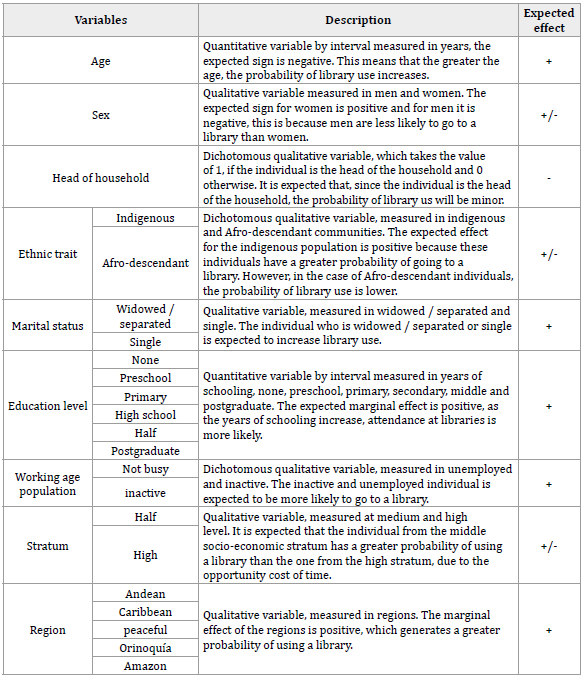
Source: Authors'own elaboration based on Porro Gutiérrez, (2007); Gray, (2011), Falk and Katz-Gerro, (2016).
METHODOLOGY
In this research, for the analysis of the supply of libraries in Colombia, the database of the Directory of Public Libraries built by the National Library of Colombia during the period 2017-2019 is used. This directory allows establishing the number of these institutions and their geographical distribution by regions and departments. Colombia is geographically divided into 6 regions (the Andean, the Caribbean, the Pacific, the Orinoquia, the Amazon and the Insular), and politically into 32 departments (the origin of the departments dates back to the 9th century, initially called provinces) (Biblioteca Nacional de Colombia, 2019). The directory presents an inventory of 1,528 libraries, located throughout the national territory, for which an inspection of the geographical location by departments is carried out, through an exploratory analysis of spatial data (AEDE). As each region is made up of departments, the number of libraries in each region can also be established. For this, the quantiles are used, the box plot, the distributions, patterns and atypical areas are visualized.
The studying demand survey of cultural consumption (ECC), made during the first quarter of 2018, by the National Administrative Department of Statistics (DANE, 2018), is composed of a population over 12 years of age, with a total of 26,805 people surveyed from the municipal seats of the departments of the national territory. From the cultural consumption survey, the following variables are used: age, sex, head of household, ethnic trait, marital status, educational level, working-age population, socioeconomic stratum and region, to develop a descriptive analysis of the profile of library users and estimate the Probit econometric model which allows the analysis of specific characteristics of the individual which generate a greater probability of library use. It should be clarified that this study exclusively includes the variables of the Cultural Consumption Survey.
MODEL
The Probit model is an efficient regression econometric model to calculate the probability of library demand and use. The dependent variable indicates that the value of 1 represents yes, they have used libraries in the last 12 months, and 0 if they haven't been to libraries in the last 12 months. Regarding the independent variables, those of human capital stand out: age, level of education; and in the variables of socioeconomic context we find, socioeconomic stratum, head of household, working-age population, which in turn is divided into economically active population (employed and unemployed) and economically inactive population (inactive). In the personal characteristics are sex, marital status, cultural traits and region.
The Probit probability model is associated with the cumulative normal probability function. Where Zi is determined by an explanatory variable X,
Zi = a + ßXi (Gujarati and Porter 2010, 566-573)
Given the difficulties associated with the linear probability model, it is natural to transform the original model in such a way that the predictions fall in the interval of (0, 1) for all X, the requirement of such a process is that it translates the values of the attribute X, which can vary over the entire real line, at a probability that varies from 0 to 1
Where Zi is the value determined by an explanatory variable X.
Probability distribution
Econometric specification
The model relates the dependent variable Yi, with the explanatory variables of interest that is made through econometric estimates and is specified as follows (Gujarati and Porter 2010, 566-573).
Yi probit = βi + β2edadi + β3edadli + β4sexoi + βSjefei + βbRasgo etnicoi + βlestado civili + βQeducacioni + β9Poblac en edad trabajari + β10estratoi + β11regioni + ui
Where; μi ~ NID (0 , σ 2 )
The estimation will be made through the maximum likelihood method, assuming normality in the distribution of errors (Probit model).
Thus defining, Yi as a logistic or pyro-ballistic binary variable, which takes the value of 1 if they went to libraries in the last 12 months and 0 if they did not attend libraries in the last 12 months.
Finally, in all the estimations the matrix of variances and covariances of the estimated coefficients proposed by (White, 1980) was used, in order to have robust estimators, allowing the statistical inference (hypothesis test) to be carried out appropriately.
In order to understand the use of the variables in Table 2, the presentation and description of the variables will be made.
RESULTS
Initially, the results of the supply of libraries in Colombia are presented by means of an exploratory analysis of spatial data (AEDE), later the results of the descriptive profile of the individual who attend libraries are presented, and finally the results of the Probit model are presented. that allows to analyze which characteristics of the individual generate a greater probability of assistance.
The Exploratory Analysis of Spatial Data (AEDE) is a discipline within the more general statistical analysis, designed for the specific treatment of geographic data. This is constituted by various techniques that allow exploring spatial data, detecting patterns, studying associations, recurring behaviors in the data, formulating hypotheses about the presence of spatial phenomena within the data, identifying cases or subsets of unusual or atypical data given their location on a map (Yrigoyen, 2009).
Table 2 Description of the variables
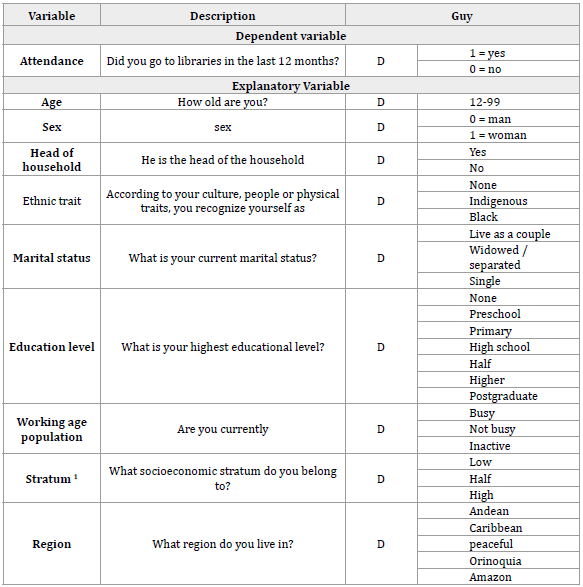
In Colombia a socio-economic stratification is used based on the physical characteristics of the home and the environment in which it is located. Thus, the low stratum corresponds to lower levels of income, education and employment; and people who live in the middle stratum, and especially in the upper stratum, have greater opportunities for education and income.
Source: Authors' own elaboration based on ECC (DANE, 2018).
Results of the Supply of Libraries in Colombia
According to the results, Colombia has 1,528 public libraries, distributed by regions as follows: in the Andean region with 819 public libraries, followed by the Pacific region with 305, the Caribbean region with 269, the Orinoquia region with 74, the region Amazonia with 59, and the Insular region with 2 institutions. It is important to highlight that the departments of the Andean region have a greater opportunity for economic growth and development as well as cultural ones, since there is a large concentration of public libraries in the most important departments of the country, which are areas with the greatest socioeconomic growth. On the other hand, there are fewer public libraries in the regions most affected by the internal armed conflict, which today are part of post-conflict areas, presenting a great opportunity for the implementation of public policies aimed at increasing reading rates and access to libraries (Palma, Aguado and Osorio, 2014). According to the above, the availability of these cultural spaces significantly influences the attendance of the population, so it is relevant to highlight the value and importance of having a key cultural infrastructure (Parra & Corzo, 2008). Figure 1 shows the total distribution of public libraries in Colombia which can be viewed by department.
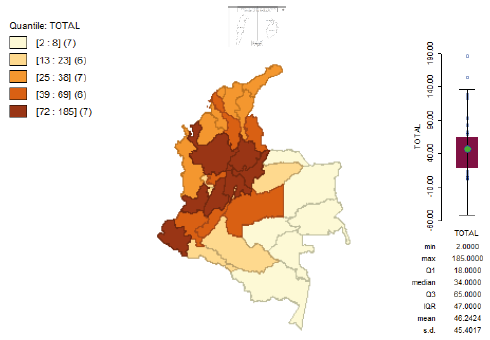
Source: Authors’ own elaboration based on the Directory (Biblioteca Nacional de Colombia, 2019).
Figure 1 Total distribution of public libraries in Colombia
Performing the analysis by departments based on the data in Figure 1, it is highlighted that the departments in dark red are those that have the largest number of libraries, thus there is Antioquia with 185 public libraries, Cundinamarca with 154 (where the capital of the country, Bogotá, is located), Boyacá with 127, Valle del Cauca with 122, Santander with 93, Nariño with 82, and Tolima with 72. While the departments in light yellow color are those that have low levels of concentration of public libraries; we find Arauca with 8 public libraries, Guaviare with 8, Amazonas with 6, Vichada with 5, Vaupés with 4, Risaralda with 3, Guainía with 2; and in the insular part, San Andrés and Providencia with 2 institutions. The other departments have a concentration of public libraries ranging from 13 to 69 institutions, represented with the colors, dark yellow, light orange and dark orange, as evidenced in the map.
It is concluded that the departments of Antioquia, Cundinamarca (where the capital of the country, Bogotá, is located) and Boyacá, belonging to the Andean region, have the largest number of public libraries, while the departments that make up the regions of the Amazon and the Orinoquia are the ones with the least number of public libraries, as there are also few institutions in the island region of the country.
Once the geographical location of public libraries in Colombia has been analyzed, establishing that there is a significant concentration in the departments that are a core of regional growth, and that there are very few of these institutions in regions that have lagged behind in the economic development of the country, and on occasions affected by the long internal armed conflict. We identify a great opportunity for post-conflict public policies that are being developed in the country. In addition to this information, it is important to develop an analysis of the demand of these institutions which complements the research.
According to the analysis of the demand for public libraries in Colombia, in the period in which this study is carried out, there is an active participation of 19.7% of the total population, which is an important number for a country with low-income levels, education, and high exclusion. Certainly, there has been a decrease in recent years, because, for example, in 2010 the attendance to libraries in the country was with a participation of 24.5% of the population. It is therefore important to study the factors that affect the demand for these institutions, taking into account the available supply.
Descriptive Profile of the Individual Who Attends Public Libraries
Next, Table 3 shows the results of the descriptive profile of the people who demand the use of libraries in the country.
In the descriptive analysis, it can be established that the average age of attendance is 39 years, that women have a slightly higher participation in library attendance with a percentage of 53% compared to the percentage of participation of men, which is 47 %. Likewise, 85% of the population that attends the library does not recognize itself under any ethnic group, on the other hand, the population that recognizes itself as Afro-descendant has a participation of 10%, and finally the indigenous population participates with 5% assistance. The highest percentage corresponds to not being the head of the household with 68%, and the lowest to being the head of the household with 32% of the total population, which can be interpreted as a higher cost of time when there are responsibilities at home. Regarding marital status, a large percentage lives with a partner with 47%, in the second instance, single with 36% and on the other hand, the widowed / separated category is 17%.
There is more participation when the levels of education are higher, so that people with a higher education participate 27%, with secondary education 19%, primary also 19%, and postgraduate with 3%. Eventhough postgraduate is the highest educational level with respect to other levels of education, there is a small number of people who have this title in Colombia. 52% of the individuals surveyed state that they are employed, while 43% state that they are inactive, and only 5% are unemployed. The highest participation is found in the lower socioeconomic stratum (75%), followed by the middle stratum (23%), and very little participation in the upper stratum (2%).
In relation to the demand by regions of the country, it can be observed that the Andean region has the highest use of these institutions; thus, 48% of its population makes use of the public library. It should be noted that the capital of Bogotá alone participates with 15.5% of this demand. Next is the Caribbean region with an attendance of 20.9% of its population, and then there are the Pacific regions with a use of 17.2%, and the Amazon and Orinoquia regions with 13.6%. However, it can be established that, although the Caribbean region has a greater use than the Pacific region, there is a greater number of libraries in the Pacific region (305 public libraries), than in the Colombian Caribbean region (269 libraries public). The above data is interesting to establish new public policies that can improve the supply-demand relationship of these institutions in the regions.
Apart from the descriptive profile of the individual who goes to public libraries in Colombia, it is important to know which of their characteristics generate a greater probability of using these spaces. For this, a model is developed based on data from the Cultural Consumption Survey carried out by DANE in 2017.
Model Results
In this context, it is clear that discrete choice models focus on estimating the probabilities for different alternatives or observed outcomes (Greene & Hensher, 2010). Therefore, the estimated values of the coefficients do not have a direct interpretation. In principle, their sign (direction) and statistical significance are of interest if the estimated coefficient associated with a variable is positive and statistically significant. Then it is indicating that the variable in question is a factor that increases the probability of participation. Likewise, to facilitate interpretation, the calculations of the marginal effects that provide the effect size of the variables are presented (Palma et al., 2014). Next, Table 4 presents the results obtained from the model.
Table 4 Probit model
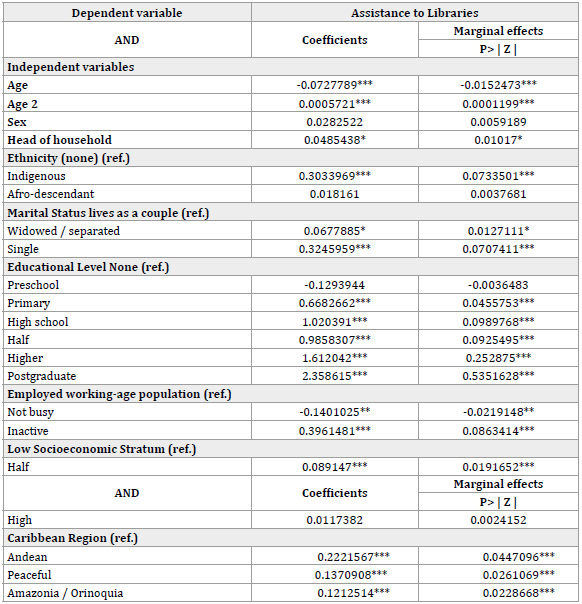
Source: Authors' own elaboration based on ECC2017.
Note: *** p <0.01; ** p <0.05; * p <0.1; R2 = 0.2560
According to the estimation of the Probit model, it is observed that the sex variable that measures participation by gender in the country did not give statistically significant, but if the age of the individual, for example, for an additional year that the individual fulfills, the probability of attending a library decreases by 2%, based on this, the older the individual is, the lower the probability that they will attend a library.
The head of household variable is statistically significant. Accordingly, if an individual is the head of the household, the probability of attending a library increases by 1% with respect to not being so. Next, there is another statistically significant variable called ethnic trait, in which those individuals who self-recognize as indigenous are associated with a 7% increase in attendance at libraries compared to people who do not recognize themselves with any ethnic trait.
In a singular way, the variable marital status was statistically significant, this means that, if the individual is widowed / separated and single, the probability of attending a library increases by 1% and 7% respectively with reference to an individual living as a couple.
In the education variable, all levels of education have significance except for the level of preschool education. It should be noted that the probability of attending a library increases in percentage as the educational level is higher, that is, it starts from primary school with 5%, followed by secondary, middle and higher with 10%, 9% and 25% respectively and ends at the postgraduate level with 54% compared to any year of education level.
Following the sequence, when a person of working age is unemployed, the probability of using a library decreases by 2% with respect to the employed.
Similarly, if the person is inactive, the probability of going to the library increases by 9% with respect to the occupied.
Furthermore, if the individual is in a middle socioeconomic stratum, the probability of using a library increases by 2% with respect to those of individuals belonging to a low socioeconomic stratum.
Finally, with respect to the region variable, the Caribbean region is taken as a reference, since all regions are statistically significant. The probability of using a library increases if the individual belongs to the Andean region (with the capital of Bogotá included) by 4.4%, to the Pacific region by 2.6%, and to the Amazon / Orinoquia regions by 2.2%.
CONCLUSIONS
The library is recognized in Colombia as an institution that has the fundamental purpose of increasing social capital, promoting inclusion, generating equity in a society of exclusion and social conflicts, gaining special importance in the post-conflict period. Currently, the library, apart from offering educational content, also serves as a place for recreation and meeting, which can be used in different ways, since most have spaces such as video game rooms, cinema, music, museum, as well as cafeterias. and restaurants, among other areas.
The importance of these places in Colombia is contemplated in Law 1379 of 2010, "by which the national network of public libraries is organized and other provisions are dictated", also in the National Development Plan 2018-2022, called " Pact for Colombia, pact for equity ", where one of the points is the development of library projects in rural communities for the construction of social fabric and equity, Moreover, Law 1834 of May 23, 2017, called Orange Law, seeks to promote infrastructure projects for libraries in urban areas, ensuring their existence and expansion in the national territory.
The high levels of concentration of public libraries are in the departments of Antioquia, Cundinamarca (including the capital city of Bogotá), and Boyacá. The previous departments belong to the Andean region, that is, this region is the one with the largest offer of public libraries. Likewise, the departments with the least coverage are those belonging to the Amazon and Orinoquia regions along wih those belonging to the insular region. In accordance with the above, the departments, and therefore the regions, that have the most development and economic growth are in fact the areas that have the greatest number of public libraries, and there are very few of these institutions in regions that have lagged behind in the economic development of the country, and at times affected by the long internal armed conflict, showing a great opportunity for the post-conflict public policies that are developed in the country.
It can also be established that, although the Caribbean region has a greater library us than the Pacific region, there is a greater number of libraries in the Pacific region than in the Colombian Caribbean region. The above data is interesting in order to establish new public policies that can improve the supply-demand relationship of these institutions in the regions of the country.
On the demand side of these institutions, in the study of the descriptive profile, it can be observed that the average age of the visitor is 39 years, with a greater participation of women. In addition, the individuals with the highest library use show the following characteristics: They do not recognize themselves as a part of a minority group; most of them live as a couple; have intermediate and higher educational levels and they are currently employed. However, there is a significant participation of those who are inactive. Likewise, greater library use was found for people belonging to low-income strata and living in the Andean region. As explained, it is this region that has the greatest socioeconomic development in the country, with a greater supply of public libraries.
Based on the results of the model, it admits analysis of which individual characteristics generate a greater probability of library use. The probability is higher for individuals who are heads of household and individuals who self-recognize as indigenous. Like people who do not have a partner, they are more likely to visit these places than those who do. All levels of education were significant for library use and the probability increases as a higher level is achieved. The average socioeconomic level is statistically significant for library use and also belonging to any region of the country. In relation to the activity carried out, it is important to note that being in a state of inactivity favors the probability of the individual to go to these spaces. Likewise, it is important to determine that the probability of going to a library decreases with age and when a person of working age is unemployed.
The use of the public library has an important role in the quality of life of the population, this in accordance with what was found in the study by Fujiwara, et al. (2019), likewise, as found by Smith (2000) and Prieto, et al. (2005), educational level is a determinant of library use and attendance increases with higher levels of education. The government must allocate a greater part of the budgetary investment in the cultural assets of the country, especially the public library, a vital space to promote the development and growth of the country, concentrating its attention on the most vulnerable population, particularly those areas that do not have a great offer, with the aim of promoting social inclusion.

















